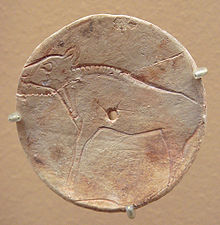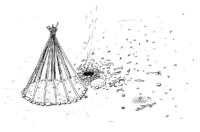- Magdalenian
-
The Magdalenian (French: Magdalénien), refers to one of the later cultures of the Upper Paleolithic in western Europe, dating from around 17,000 BP to 9,000 BP. It is named after the type site of La Madeleine, a rock shelter located in the Vézère valley, commune of Tursac, in the Dordogne department of France.
Originally termed "L'âge du renne" (the Age of the Reindeer) by Édouard Lartet & Henry Christy, the first systematic excavators of the type site, in their publication of 1875, the Magdalenian is synonymous in many people's minds with reindeer hunters, although Magdalenian sites also contain extensive evidence for the hunting of red deer, horse and other large mammals present in Europe towards the end of the last ice age. The culture was geographically widespread, and later Magdalenian sites have been found from Portugal in the west to Poland in the east.
Contents
Duration
The culture spans the period between c. 18,000 and 10,000 BP, towards the end of the last ice age. The Magdalenien is characterised by regular blade industries struck from carinated cores. Typologically the Magdalenian is divided into six phases which are generally agreed to have chronological significance. The earliest phases are recognised by the varying proportion of blades and specific varieties of scrapers, the middle phases marked by the emergence of a microlithic component (particularly the distinctive denticulated microliths) and the later phases by the presence of uniserial (phase 5) and biserial 'harpoons' (phase 6) made of bone, antler and ivory.[1]
There is extensive debate about the precise nature of the earliest Magdalenian assemblages, and it remains questionable whether the Badegoulian culture is in fact the earliest phase of the Magdalenian. Similarly finds from the forest of Beauregard near Paris have often been suggested as belonging to the earliest Magdalenian.[2] The earliest Magdalenian sites are all found in France.
The serphants phases of the Magdalenian are also synonymous with the human re-settlement of north-western Europe after the Last Glacial Maximum during the Late Glacial Maximum. Research in Switzerland, southern Germany [3] and Belgium [4] has provided AMS radiocarbon dating to support this.
By the end of the Magdalenian, the lithic technology shows a pronounced trend towards increased microlithisation. The bone harpoons and points have the most distinctive chronological markers within the typological sequence. As well as flint tools, the Magdalenians are best known for their elaborate worked bone, antler and ivory which served both functional and aesthetic purposes including perforated batons. Examples of Magdalenian portable art include batons, figurines and intricately engraved projectile points, as well as items of personal adornment including sea shells, perforated carnivore teeth (presumably necklaces) and fossils.
The sea shells and fossils found in Magdalenian sites can be sourced to relatively precise areas of origin, and so have been used to support hypothesis of Magdalenian hunter-gatherer seasonal ranges, and perhaps trade routes. Cave sites such as the world famous Lascaux contain the best known examples of Magdalenian cave art. The site of Altamira in Spain, with its extensive and varied forms of Magdalenian mobillary art has been suggested to be an agglomeration site where multiple small groups of Magdalenian hunter-gatherers congregated.[5]
In northern Spain and south west France it was superseded by the Azilian culture. In northern Europe we see a slightly different picture, with different variants of the Tjongerian techno-complex following it. It has been suggested that key Late Glacial sites in south-western Britain can also be attributed to the Magdalenian, including the famous site of Kent's Cavern, although this remains open to debate.
See also
Preceded by
SolutreanMagdalenian
17,000–9,000 BPSucceeded by
AzilianThe Stone Age
↑ before Homo (Pliocene)
Wild Animals Stone tool
Paleolithic- Lower Paleolithic
Early Stone Age - Middle Paleolithic
Middle Stone Age- Homo neanderthalensis
- Homo sapiens
- Recent African origin of modern humans
- Upper Paleolithic
Late Stone Age
- Heavy Neolithic
- Pre-Pottery Neolithic
- Pottery Neolithic
↓ Chalcolithic In movies
In the movie The Man from Earth , the protagonist claims that he is a 14000 year old Magdalenian i.e., Cro-Magnon.
References
Sources
- Charles, R. (1996): Back into the North: the Radiocarbon evidence for the Human Recolonisation of the North Western Ardennes after the Last Glacial Maximum. Proceedings of the Prehistoric Society 62: 1-17.
- Conkey, M.J. (1980): The identification of prehistoric hunter-gatherer aggregation sites: the case of Altimira. Current Anthropology 21: 609-630.
- Hemingway, M.F. (1980): The Initial Magdalenian in France. British Archaeological Reports International Series 90. 2 Vols.
- Housley, R.A, Gamble, C.S., Street, M. & Pettit, P. (1997): Radiocarbon Evidence for the Lateglacial Human Recolonisation of Northern Europe. Proceedings of the Prehistoric Society 63.
- Lartet, E & Christy, H. (1875): Reliquae Aquitanicae: being contributions to the archaeology of Périgord and adjoining provinces of Southern France. Williams & Norgate. London.
- Sonneville-Bordes, D. de & Perrot J. (1954–1956): Lexique typologique du Paléolithique supérieur. Bulletin de la Société Préhistorique Française 51: 327-335, 52: 76-79, 53: 408-412, 53: 547-549.
- Straus, Lawrence Guy (1992) : Iberia Before the Iberians. University of New Mexico Press.
External links
- pictures and description of the La Madeleine site [1]
- Picture Gallery of the Paleolithic (reconstructional palaeoethnology), Libor Balák at the Czech Academy of Sciences, the Institute of Archaeology in Brno, The Center for Paleolithic and Paleoethnological Research
Categories:- Archaeological cultures
- European archaeology
- Stone Age Europe
- Upper Paleolithic
- Lower Paleolithic
Wikimedia Foundation. 2010.






